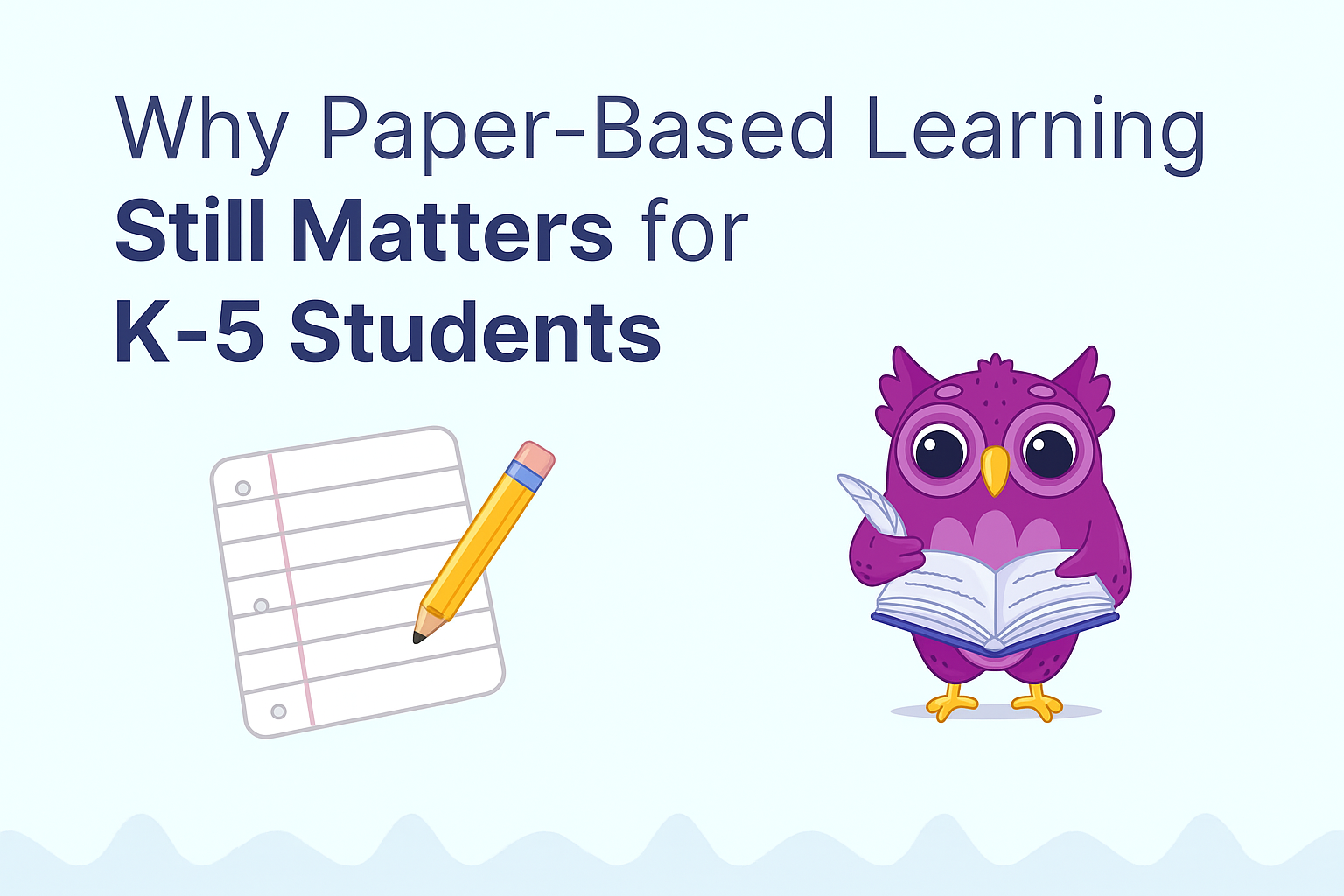10 Reasons Why Paper-Based Learning Still Matters for K-5 Students
Keep kids focused and thriving with 10 reasons to choose paper-based learning. Boost skills, memory, and focus with worksheets, workbooks, and hands-on activities that truly make a difference.
In today’s tech-driven classrooms, it’s easy to assume digital tools have replaced traditional learning methods. But for Kindergarten through 5th-grade students, paper-based learning remains an essential foundation for long-term academic success. From handwriting practice to tangible reading materials, the benefits go far beyond nostalgia.
- Strengthens Fine Motor Skills
- Improves Focus and Reduces Distractions
- Boosts Memory and Retention
- Encourages Active Engagement
- Builds Strong Reading Habits
- Offers a Break from Screen Time
- Makes Learning More Personalized
- Encourages Responsibility and Organization
- Simplifies Assessment and Feedback
- Supports Equity in the Classroom

Below are 10 powerful reasons why paper-based learning is still one of the best choices for young learners.
1. Strengthens Fine Motor Skills
Why It Matters:
Writing with a pencil, coloring with crayons, cutting with scissors - these hands-on tasks are vital for developing fine motor skills in early childhood. Paper-based learning offers ample opportunities to practice these foundational skills that digital tools can't fully replicate.
How It Helps:
Children improve hand-eye coordination, pencil grip, and muscle control, all of which are essential for writing, drawing, and daily tasks like tying shoelaces.
Bonus Tip:
Use tracing worksheets, cut-and-paste activities, and simple coloring pages to support early motor development.
2. Improves Focus and Reduces Distractions
Why It Matters:
Unlike tablets or laptops, paper doesn’t ping with notifications or open new apps with a swipe. This helps kids stay locked in on the task at hand.
How It Helps:
Paper-based tasks foster better concentration and attention span, allowing students to fully engage with the lesson. This can reduce off-task behavior and help improve classroom management.
Bonus Tip:
Use printed worksheets for quiet independent work time or as part of a focused literacy or math center.
3. Boosts Memory and Retention
Why It Matters:
Studies show that writing things down by hand helps students remember information better than typing or tapping.
How It Helps:
The act of writing activates areas in the brain linked to comprehension and memory formation. When students write out spelling words, math problems, or reading responses, they internalize the material more effectively.
Bonus Tip:
Encourage kids to keep daily learning journals or reflection notebooks as part of their paper-based learning routine.
4. Encourages Active Engagement
Why It Matters:
Paper worksheets and workbooks often include coloring, matching, circling, drawing lines, and writing answers - all interactive elements that keep kids engaged.
How It Helps:
Active participation increases cognitive processing. Kids stay physically and mentally involved, which leads to deeper understanding and learning retention.
Bonus Tip:
Add interactive elements like sticker rewards or foldable templates to paper assignments for more engagement.
5. Builds Strong Reading Habits
Why It Matters:
Paper books, whether storybooks or printed readers, help children develop deeper reading comprehension and stronger connections to text.
How It Helps:
Students are more likely to slow down, visualize, and interact with the text in a tactile format. They can flip pages, underline words, and even annotate - something many digital tools discourage.
Bonus Tip:
Use printed reading logs or comprehension worksheets to pair with take-home books or guided reading sessions.
6. Offers a Break from Screen Time
Why It Matters:
Many kids already get too much screen time at home. Adding more in school can lead to eye strain, behavioral issues, and fatigue.
How It Helps:
Paper-based learning provides a much-needed break from blue light and passive scrolling. It promotes calmness and supports healthier classroom behavior.
Bonus Tip:
Balance your tech use with paper worksheets and workbook time. Alternate between screen-based activities and printable tasks to reset attention.
7. Makes Learning More Personalized
Why It Matters:
Paper workbooks and printables can be easily customized or adjusted for each student's level or interest.
How It Helps:
Teachers can tailor tasks by modifying reading levels, simplifying instructions, or providing differentiated activities. Students benefit from learning that meets them where they are.
Bonus Tip:
Use a worksheet website like ClassWeekly.com to build personalized workbooks aligned with your students’ needs and grade levels.
8. Encourages Responsibility and Organization
Why It Matters:
Managing paper assignments teaches kids to be organized and responsible for their own work.
How It Helps:
From filing worksheets into folders to completing workbook pages by due dates, students learn to manage materials and stay on track - key skills for lifelong learning.
Bonus Tip:
Give kids folders, binders, or interactive notebooks where they store completed paper assignments, goals, or checklists.
9. Simplifies Assessment and Feedback
Why It Matters:
Paper-based assignments are quick to grade and easy to annotate with personalized teacher comments.
How It Helps:
Students benefit from immediate, tangible feedback they can touch, see, and reread. Parents can also review progress more easily with paper-based portfolios or folders.
Bonus Tip:
Highlight successes with stickers, stamps, or notes of encouragement on worksheets to boost motivation.
10. Supports Equity in the Classroom
Why It Matters:
Not every child has access to devices or reliable internet at home. Paper resources ensure all students can participate equally, regardless of tech access.
How It Helps:
Paper-based learning levels the playing field and gives every child a fair shot at success. It reduces reliance on tech and ensures no child is left behind due to digital barriers.
Bonus Tip:
Send home printed packets or workbooks for students with limited access to digital tools so learning can continue outside of class.
Final Thoughts
Paper-based learning isn't outdated - it’s timeless. Especially in the critical K-5 years, students benefit immensely from engaging with physical materials that help them write, draw, read, and solve problems with their hands. While technology certainly has a role, paper remains a powerful learning tool that supports focus, memory, fine motor skills, and individualized instruction.
By integrating paper worksheets, printable activities, and personalized workbooks into your teaching strategy, you create a balanced and enriched educational experience. Don’t underestimate the power of pencil and paper - they’re still shaping the minds of tomorrow, one worksheet at a time.
Looking for quality paper-based learning resources?
Visit ClassWeekly.com to explore thousands of printable K-5 worksheets, customizable workbooks, and fun learning activities across math, reading, writing, grammar, and more. Whether you're a parent or a teacher, everything you need is just a click - and a print - away.

